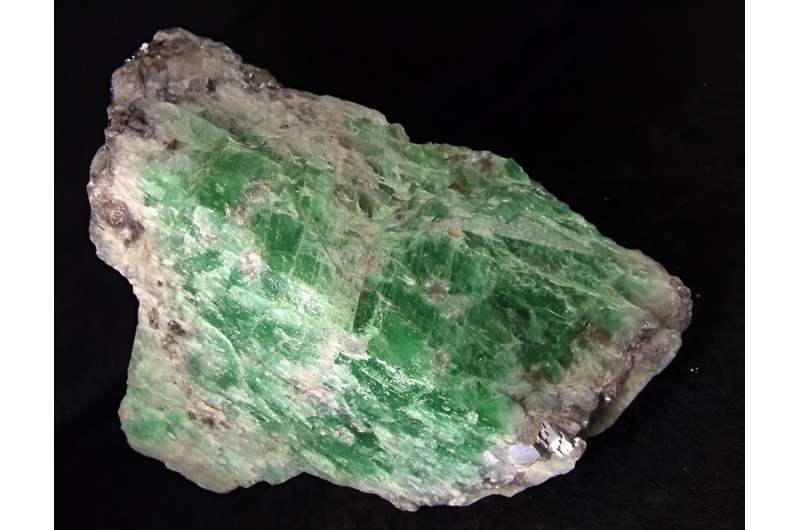This article has been reviewed according to Science X's editorial process and policies. Editors have highlighted the following attributes while ensuring the content's credibility:
fact-checked
trusted source
proofread
Green mystery: Plumbian orthoclase reveals hidden resources

Plumbian orthoclase is a bit of a mystery, but this unique Aussie mineral is part of a mining industry revolution. The mineral's glowy green hue feels otherworldly. Although this Aussie kryptonite's origin is terrestrial, it's no less surprising.
Plumbian orthoclase is incredibly rare, found exclusively around the outback mining city of Broken Hill. The word plumbian means lead-rich, and it's the lead that gives the mineral its famous green appearance.
In fact, Silver City's orthoclase has the highest lead content of its peers anywhere in the world.
Often called green feldspar, some of Broken Hill's plumbian orthoclase samples get misidentified as amazonite.
Amazonite is a microcline rather than orthoclase feldspar, a similar mineral with a slightly different chemical structure. But Amazonite's own distinctive green style makes for some mineral mistaken identities. This colorful confusion has caused heated global debate about the properties of the two minerals and what we should call them.
Although plumbian orthoclase doesn't actually physically glow, our Mineral Resources team discovered something surprising about the samples.
Dr. Matt Shaw is a Research Scientist in our Mineral Resources team.
"Interestingly, in-house examinations in our labs showed it's mildly (and I mean mildly) radioactive. Not enough to hurt anyone, only enough to read above background levels," Matt says.
Despite its attractive shade of green, our lovely lead-rich orthoclase is mostly useful in a specific context. It serves as an indicator mineral, which helps geologists locate and assess the presence of certain ore deposits, such as the unique lead and zinc deposits of Broken Hill.
Broken Hill: A unique geology
Mining has been intrinsic to the Broken Hill area since Charles Rasp discovered silver there in 1883. Rasp formed the Broken Hill Proprietary Co Ltd, better known as BHP.
Geologists and mining experts disagree on what made the Broken Hill deposits so complicated, providing a rich vein of debate. The area's geology is fascinating, with a boomerang-shaped ore body, its highest point sticking out in the middle.
Here, we find deposits of unusual form and size with metamorphic host rocks. Metamorphic host rocks are rocks that have undergone transformation through intense heat and pressure, making them crucial settings for the formation of these deposits.
Broken Hill is one of the world's largest lead, zinc, and silver ore deposits. It was formed millions of years ago. However, you won't find our popular plumbian orthoclase anywhere else on Earth.
Early in his career, Matt worked in Broken Hill's Rasp mine, specializing in flotation chemistry.
Matt says if you ask any metallurgist why Broken Hill is interesting, they'll probably answer it's because of the challenging geology. Or even the cutting-edge flotation process they developed there.
"But let's be honest. The real reason it's interesting is because it's the only place we can find our Aussie kryptonite," he says.
Froth flotation: Whatever floats your rock
Broken Hill's particularly strange characteristics make separating the ore from its host rocks difficult. When traditional methods proved inadequate, experts tried a previously used separation experiment that revolutionized the industry.
Early twentieth-century miners in Broken Hill's processing system used a remarkable 'froth flotation' method. This hydrometallurgy process separates valuable minerals from waste minerals by floating rocks. The area's unique chemistry means froth flotation works amazingly well.
Broken Hill mining was the first industrial application of froth flotation. This method remains an incredibly effective way of separating lead and zinc from the ore and each other.
The cutting-edge process is still used today when mining the area's lead, zinc, and silver ores.
A chemical reagent gets added to the ground-up ore, selectively making the valuable minerals hydrophobic. Then, a frothing agent is added to the slurry, and air is bubbled through. The now hydrophobic particles stick to the bubbles and float to the top and are scraped off. The non-valuable minerals that don't float are called flotation tailings.
Notable targets for flotation (and separation) include galena, a lead mineral often containing silver, and sphalerite, which gives us zinc.
Froth flotation is now everywhere, making it arguably the most widely adopted mineral processing technique worldwide. The process is frequently used for copper ores and is also effective for oxide mineral systems, including rare earth minerals like phosphate-based monazite.
Meanwhile, plumbian orthoclase is only found in one place: Australia's geologically challenged Broken Hill. Because that city pioneered a game-changing mining process, we agree the mineral deserves Matt's affectionate moniker, 'Aussie kryptonite.'
Provided by CSIRO




















